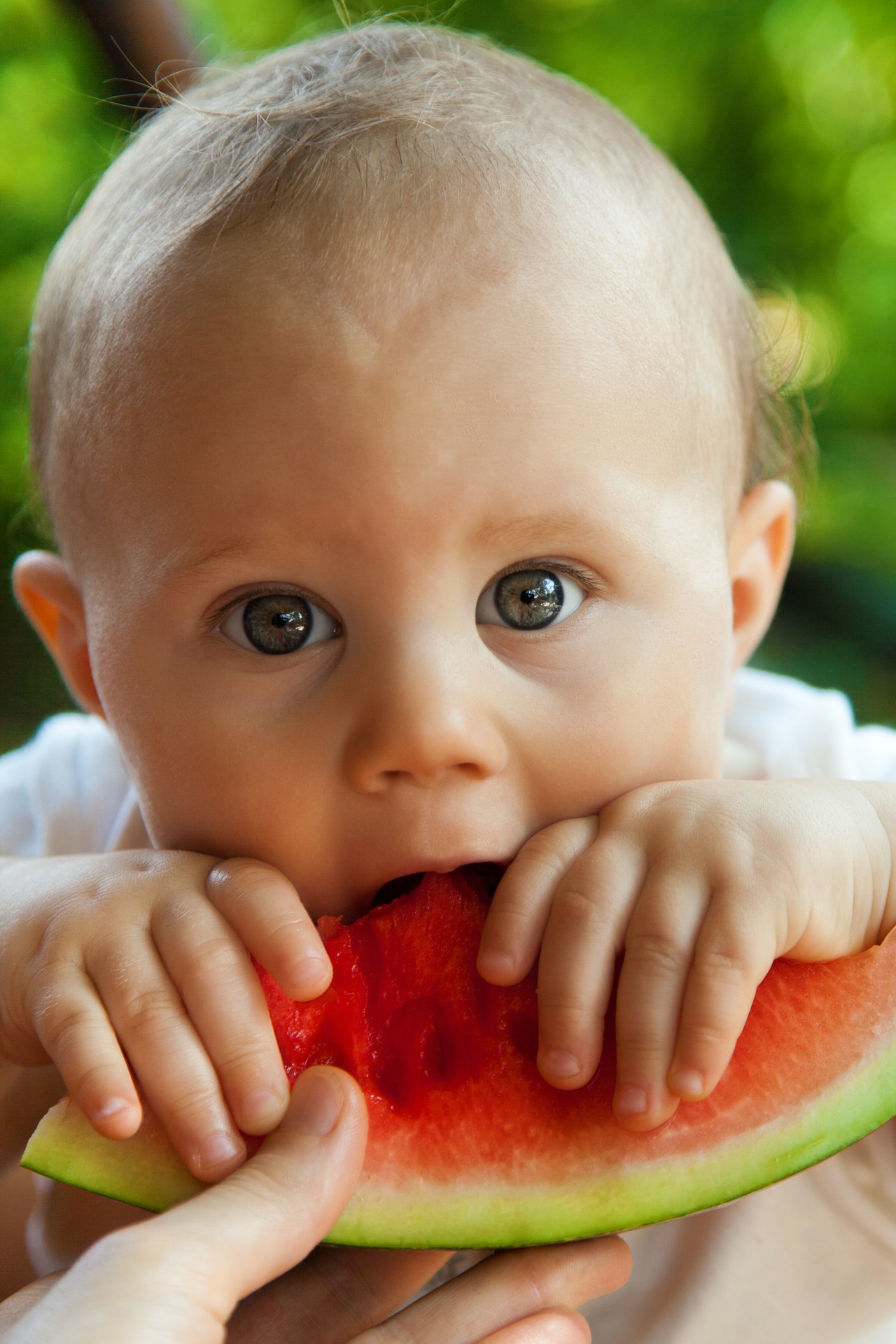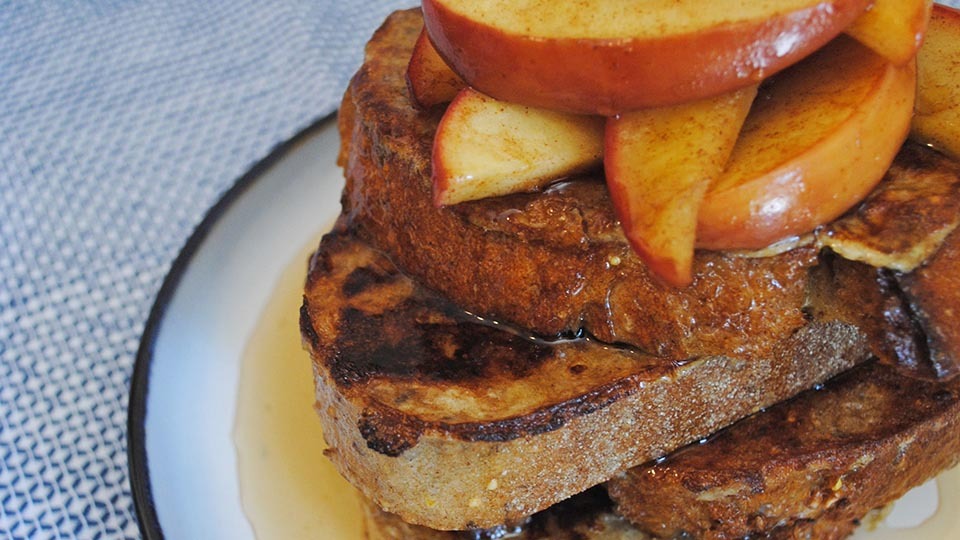American Academy of Pediatrics and Baby Led Weaning
Baby-Led Weaning: An Approach to Introducing Solid Foods to Infants

Babe feeding tin can be a challenging and daunting job especially when you consider the impact nutrition has on growth and evolution at this age. Typically, infants are introduced to pureed foods betwixt 4-6 months of age and are fed past their parents until they are able to employ utensils by themselves. New enquiry shows that in that location may be a different style to help wean babies from milk to solid foods. Baby-Led Weaning (BLW) is a rubber and effective alternative to the traditional method as it introduces solid foods in a fashion that respects an babe's autonomy, provides supplemental nutrition, and promotes healthy weight and eating behaviors (Rapley 2015). In this fact sheet, nosotros will discuss what BLW is and strategies to aid parents feed their babe using this approach.
What is Babe-Led Weaning?

BLW is the process of allowing babies to learn how to feed themselves as they transition from milk/formula to eating solid foods (Rapley & Murkett, 2010). Any foods introduced during this weaning catamenia are often referred to equally "complementary foods." The term Baby-Led Weaning was first coined in the early on 2000s, but many parents instinctually follow a baby-led approach when introducing solid foods (Rapley & Murkett, 2010). Spoon feeding became a common exercise in the mid 1900s due to the commercialization of pureed infant foods, and the practice continued as many pediatricians recommended that babies start on purees equally early as iv months (Rapley & Murkett, 2010). More current pediatric recommendations, adjustment with recent enquiry, indicates that parents should wait until their infant is 6 months of age to introduce complementary foods (American Pediatric Association, 2018; Rapley 2015). Likewise in BLW, solid foods are introduced at 6 months, when many babies are developmentally ready to handle solid foods in the course offered (Brown, Jones, & Rowan, 2017; Naylor & Morrow, 2001). When using the BLW approach, your baby will sit in a high chair at the table with the residual of the family during mealtime (Rapley & Murkett, 2010). Your baby can be offered the same foods every bit everyone else simply with a texture that is modified to be soft enough for his/her developmental age (Rapley, 2018). Encourage your baby to explore his/her food through impact, taste, olfactory property, and play. At first your infant will simply consume pocket-sized amounts of nutrient and that's ok! Breast milk or formula will proceed to provide the chief source of energy and nutrients in your baby's diet (Rapley & Murkett, 2010). Continue milk feedings throughout the transition phase of weaning, which will typically be between half dozen-12 months of age (Rapley, 2011; Rapley, 2015).
Why Infant-Led Weaning?
BLW is a logical continuation of babe-led or on demand breastfeeding/formula feeding, when infants are fed according to their own hunger cues (Cameron, Heath, & Taylor, 2012). The BLW approach aligns closely with the Ellyn Satter principles on childhood feeding. In the Ellyn Satter approach, the role of the parent is to decide when and what nutritious food to provide, and the role of the child is to decide what and how much of that food they want to eat (Satter, 2012). Similarly, BLW lets you equally a parent decide what foods to present to your infant, and your babe gets to decide which of the foods they want to try (Rapley, 2015). Benefits and supporting research on BLW are discussed in Table 1.
Table 1. Benefits and Inquiry on Baby-Led Weaning
| Benefits of BLW | Research |
|---|---|
| Responsive to hunger and satiety cues | Babies who are in control of their own food intake are meliorate at learning when they are hungry and when they are full, which also leads to healthy eating habits later in life (Satter, 2012). |
| Improved energy regulation and healthier weight | Babies who self-wean typically weigh less and have a reduced run a risk of obesity in comparison to their spoon-fed peers (Rapley, 2015; Townsend & Pitchford, 2012). |
| Chewing and swallowing skills adult | Chewing and swallowing are learned behaviors that develop between six-12 months of age, whereas purees teach the baby to suck food into their mouths without chewing beginning (Naylor & Morrow, 2001). |
| Less fussy eating and picky eaters | Your baby will acquire to relish a broad variety of tastes and textures, which according to some studies will lead to less fussy and less picky eaters (Fu et al., 2018). |
| Less stress | Mothers practicing BLW reported lower levels of food restriction, less instances of forcefulness feeding, and less business organisation over child weight (Chocolate-brown & Lee, 2011). |
| Enjoyable mealtimes | Family mealtimes have many benefits, and with BLW there is less stress involved for parents in feeding attempts and less stress for babies, too (Brown & Lee, 201; Rowan & Harris, 2012). |
| Cheaper than purees | BLW is also less complicated than spoon feeding and is more economically feasible for many families because it does not require expensive jars of pureed food or accept time to make homemade purees. |
When to Outset BLW?

Babies should be exclusively breastfed or formula fed until 6 months of age, at which point complementary foods should be introduced (World Wellness System, 2018). For about vi month one-time infants, the digestive tract, immune system, and oral motor skills are sufficiently developed to handle solid foods (Naylor & Morrow, 2001). Premature babies or babies with eating difficulties may require more time or alternative approaches to feeding (Rapley, 2015). Consult with your pediatrician if you have questions or concerns near using this technique with your infant.
From the starting time, your baby will feed himself/ herself. They will start with grasping food in their fists, and by nine months of age will exist able to pick up food using a pincer grasp with their pollex and forefinger (Rapley & Murkett, 2010). As their motor skills and hand-center coordination go more adult, your baby will exist able to first using utensils (Naylor & Morrrow, 2001).
When introducing solid foods, expect for signs of readiness. These include the following:
- Baby tin sit up unsupported (Rapley, 2015).
- Baby can grasp food in hands and move it to mouth (Rapley, 2015).
- Absenteeism of tongue thrust (Schilling & Peterson, 2017).
- Baby makes attempts at chewing, tin move nutrient to back of oral cavity and swallow.
The gut is developmentally prepare to handle food, which volition be evident in diaper content. Babies dependent on breastmilk will accept xanthous poop. As you first to feed your babe solid foods, many of these will laissez passer straight through their gut and be apparent in their poop. Over fourth dimension, babies that are beginning to assimilate foods volition have a modify in their poop, and it volition become more chocolate-brown and solid (Cichero, 2016; Naylor & Morrow, 2001, Rapley).
How to Brainstorm Babe-Led Weaning
Initiate infant-led weaning past letting your baby bring together the family unit at meal times. Time these meals to be after milk feedings, and so your infant will not be hungry and fussy while exploring new foods (Rapley, 2011; Rapley 2015). Offer your babe new foods to try. Table ii contains ideas for first foods to introduce to your babe. Cutting the food into strips that your baby can hold in their fist with some of the nutrient protruding that he can champ on (Rapley & Murkett, 2010). The texture of the food should be easily mashed betwixt your fingers, or your babe's gums, which will help forestall choking. Avoiding large chunks and hard crunchy foods until your babe is a piffling older can as well assist forestall choking (Schilling & Peterson, 2017). Also brand sure the temperature of the food is either absurd or warm, non hot, as babies have sensitive mouths.
Enjoy watching your baby suck, mash, glue, munch, throw, and play with his/her food. A favorite phrase of the BLW customs is that, "food is for fun until age one" (Pesch, 2019). Most of your baby'due south nutritional needs volition keep to be met through chest milk or formula during that first year, so focus on providing a broad variety of new foods for your baby to attempt and explore (Rapley & Murkett, 2010).
Tabular array ii. First Foods to Try and Foods to Avert
| Ideas for Complementary Foods: | Foods to Avert: |
|---|---|
|
|
Common Concerns
Choking is the most common business concern regarding BLW, as the infants have access to bigger pieces of food. Studies signal that BLW babies are no more likely to choke than babies who are spoon fed (Faungupo et al., 2016; Pesch, 2019; Rapley 2011). Following prophylactic precautions volition as well assistance reduce risk of choking.
How to preclude choking:
- Ensure your baby is always sitting upright during feedings.
- Make certain the food presented is in the proper shape, size, and texture for the babe.
- Cut food into long strips they can catch in their fists.
- Never leave your baby alone with food. (Schilling &Peterson 2017).
Information technology is likewise important to recognize the divergence between choking and gagging. Gagging is a normal and natural response that occurs when in that location is too much food in a baby's mouth (Rapley 2011). Their gag response is located higher on the tongue than in adults, so babies volition gag more often (Fangupo et al., 2016). This may be alarming at get-go. Gagging will involve spluttering, coughing, and spitting nutrient out. Lookout your baby closely to determine if they are simply gagging, and able to move air and food effectually, or if they are truly choking and there is no passage of air (Rapley, 2011; Fangupo et al., 2016).
Other concerns nigh BLW include energy and food deficiencies. Some research shows that infant-led weaning tin consequence in a lower overall calorie intake and iron intake in an infants' diets (Pesch, 2019; Townsend & Pitchford, 2012). This tin can exist hands corrected by ensuring the baby is all the same receiving plenty of milk feedings throughout the weaning process, and by offer highenergy and high-iron complementary foods. ( Cameron, Taylor & Heath, 2015; Chichero 2016b; Pesch 2019). Finally, BLW can be very messy. Use bibs, towels, mats, and rags to take hold of nutrient and aid reduce waste product (Rapley & Murkett, 2010).
Baby-led weaning is a great approach to introducing solid foods to a baby'southward diet. BLW promotes autonomy and encourages good for you eating habits that volition continue as a child grows. This approach may not be suitable for all children, especially for those with developmental or feeding disorders (Rapley 2011). Consult with your pediatrician before making changes to your child's diet and feeding style. For more than information on conventional infant feeding, run across, "Healthy Beginnings: Infant and Toddler Feeding" by Chelsea Feller and Carrie Durward. https://digitalcommons.usu.edu/cgi/viewcont ent.cgi?article=2806&context=extension_cur all
References
- American Academy of Pediatrics. Starting solid foods. HealthyChildren.org website. Available at:https://world wide web.healthychildren.org/English/agesstages/baby/feeding-nutrition/Pages/Switching-To-SolidFoods.aspx. Updated January i, 2018.
- Brown, A., Jones, South. W., & Rowan, H. (2017). Baby-Led Weaning: The Evidence to Date. Current Nutrition Reports, 6(two), 148–156. doi.org/10.1007/s13668-017-0201-2
- Brown, A., & Lee, Grand. (2011). Maternal control of kid feeding during the weaning catamenia: Differences between mothers post-obit a baby-led or standard weaning approach. Maternal and Child Health Journal, xv(eight), 1265–1271. doi.org/x.1007/s10995-010-0678-4
- Cameron, S. L., Heath, A.-L. Chiliad., & Taylor, R. W. (2012). How feasible is Baby-Led Weaning as an approach to infant feeding? A review of the evidence. Nutrients, 4(xi), 1575–1609. doi.org/10.3390/nu4111575
- Cichero, J. A. Y. (2016). Introducing solid foods using infant-led weaning vs. spoon-feeding: A focus on oral evolution, nutrient intake and quality of research to bring residual to the contend. Nutrition Bulletin, 41(one), 72–77. https://doi.org/x.1111/nbu.12191
- Fangupo, Fifty. J., Heath, A.-L. M., Williams, Southward. M., Williams, L. W. E., Morison, B. J., Fleming, E. A., … Taylor, R. West. (2016). A Baby-Led arroyo to eating solids and risk of choking. Pediatrics, 138(4), e20160772. doi.org/10.1542/peds.2016-0772
- Fu, X., Conlon, C. A., Haszard, J. J., Beck, K. L., von Hurst, P. R., Taylor, R. West., & Heath, A.-L. M. (2018). Food fussiness and early feeding characteristics of infants following Baby-Led Weaning and traditional spoon-feeding in New Zealand: An net survey. Appetite, 130, 110–116. doi.org/x.1016/j.appet.2018.07.033
- Naylor, A. J., & Morrow, A. 50. (2001). Reviews of the relevant literature concerning infant immunologic, gastrointestinal, oral motor and maternal reproductive and lactational development. Linkages. 44.
- Pesch, D. (2019). Introducing complementary foods in infancy. Contemporary Pediatrics, 36(1), 6.
- Rapley, G. (2011). Baby-led weaning: transitioning to solid foods at the baby's own pace. Community Practitioner, 84(6), 5.
- Rapley, G. (2015). Baby-led weaning: The theory and bear witness behind the approach. Journal of Health Visiting, 3(iii), 144–151. doi.org/10.12968/johv.2015.3.iii.144
- Rapley, G. A. (2018). Infant-led weaning: Where are we at present? Nutrition Bulletin, 43(three), 262–268. doi.org/10.1111/nbu.12338
- Rapley, G., & Murkett, T. (2010). Infant-Led Weaning (second ed.). New York, NY: The Experiment.
- Satter, Due east. (2012). How to get your kid to swallow: But not as well much. Chicago, IL: Bull Publishing Company.
- Schilling, L., & Peterson, W. J. (2017). Built-in to swallow: whole, healthy foods from baby'south kickoff bite. New York, NY: Skyhorse Publishing.
- Globe Health Arrangement. Infant and young child feeding. (2018, February xvi). Retrieved May 23, 2019. https://www.who.int/news-room/fact-sheets/detail/infant-and-young-child-feeding.
Authors
Lydia Bangerter Dietetics Educatee; Mateja R. Savoie Roskos PhD, MPH, RD; Casey Coombs MS, RD

Casey Coombs
Create Better Health Utah (SNAP-Ed), Banana Managing director
Home and Community Department
Phone: 435-797-3725
Related Nutrition Manufactures
Source: https://extension.usu.edu/nutrition/research/baby-led-weaning-an-approach-to-introducing-solid-foods-to-infants


0 Response to "American Academy of Pediatrics and Baby Led Weaning"
Post a Comment